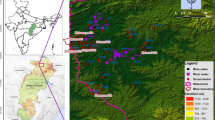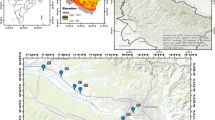Abstract
A chemometric study on physico-chemical variables of Calera River basin waters located to the northeast of the province of Tucumán, Argentina was carried out. This underground resource is an important alternative for water supply, and agricultural and cattle activities in this area. A physico-chemical analysis of 44 (forty-four) underground and Calera River water samples was carried out. Chemometric tools were used to determine which variables are more relevant and their possible associations, and also to identify the drillings whose waters are more representative of the area under study. Principal Component Analysis (PCA) and Cluster Analysis (CA) were applied for this purpose. The PCA allowed us to establish that the most important variables in this region are bicarbonate, sulfate and sodium. These ions are the main constituents of the minerals and rocks which form the geological structure of this region since there are limestone deposits (calcium carbonate), gypsum (calcium sulfate dihydrate) and halite (sodium chloride) irregularly distributed all over the region. Besides, an association between bicarbonate with sodium and sulfate with calcium variables was determined by means of CA. The most representative wells of the region under study were also selected by applying PCA. Based on these data, a regional hydrogeochemical model considering the chemical characteristics of waters and their possible interactions with the environment in which they circulate was carried out. The dissolution and/or hydrolysis of minerals present in rocks were established as important chemical processes in the area.








Similar content being viewed by others
References
APHA, AWWA, WPCF (1992) Standard methods for the examination of water and wastewater. In: DSA de Santo (ed) Madrid, España
Boemo A, Musso H, Lomniczi I (2010) Polluted aquifers: identification and characterisation by statistical analysis. Water Sci Technol 61(2):331–337
Bossi G (1969) Geología y estratigrafía del sector sur del Valle de Choromoro. Acta Geol Lilloana 10(2):19–61
Cloutier V, Lefevre R, Therrien R, Savard M (2008) Multivariate statistical analysis of geochemical data as indicative of the hydrogeochemical evolution of groundwater in a sedimentary rock aquifer system. J Hydrol 353(3–4):294–313
Custodio E y Llamas M (1996) Hidrología subterránea. Ed. Omega. Barcelona. España. Tomos I y II
D´Urso C, Rodríguez G, Sales A, Rodríguez M (2007) Hidroquímica de la cuenca del río Calera, provincia de Tucumán, República Argentina. Estud Geol 63(1):53–63
Helena B, Pardo M, Vega M, Barrado E, Fernandez JM, Fernández L (2000) Temporal evolution of groundwater composition in an alluvial aquifer (Pisuerga River, Spain) by principal component analysis. Water Res 34(3):807–816
Kowalkowski T, Zbytnievwski R, Szpejna J, Buszewski B (2006) Application of chemometrics in river water classification. Water Res 40:744–752
Kunwar PS, Amrita M, Dinesh M, Sarita S, Vinod KS (2005) Chemometric data analysis of pollutants in wastewater—a case study. Anal Chim Acta 532:15–25
Lecomte KL, Pasquini AI, Depetris PJ (2005) Mineral weatering in a semiarid mountain river: its assessment through PHREEQC inverse modeling. Aquat Geochem 11:173–194
Lomniczi I, Boemo A, Musso H (2007) Location and characterization of pollution sites by principal component analysis of trace contaminants in a slightly polluted seasonal river: a case study of the Arenales River (Salta, Argentina). Water SA 33(4):479–485
Morales MM, Martí P, Llopis A, Campos L, Sagrado S (1999) An environmental study by factor analysis of surface seawaters in the Gulf of Valencia (Western Mediterranean). Anal Chim Acta 394(1):109–117
Peña D (2002) Análisis de datos multivariantes. Ed. McGraw Hill, España
Praus P (2005) Water quality using SVD-based principal component analysis of hydrological data. Water SA 31(4):417–422
Rodier J (1981) Análisis de las Aguas, Ed. Omega, Barcelona, España
SappaG ErgulS, Ferranti F (2014) Geochemical modeling and multivariate statistical evaluation of trace elements in arsenic contaminated groundwater systems of Viterbo Area, (Central Italy). Springer Plus 3(237):1–19
Sharif MU, Davis RK, Steele KF, Kim B, Kresse TM, Fazio JA (2008) Inverse geochemical modeling of groundwater evolution with emphasis on arsenic in the Mississippi River Valley alluvial aquifer, Arkansa (USA). J Hydrol 350:41–55
Simeonov V, Stratis JA, Samara C, Zachariadis G, Voutsa D, Amthemidis A, Sofoniou M, Kouimtzis T (2003) Assessment of the surface water quality in Northern Greece. Water Res 37(17):4119–4124
Acknowledgments
CIUNT. Consejo de Investigaciones de la Universidad Nacional de Tucumán. Project 26/G518.
Author information
Authors and Affiliations
Corresponding author
Rights and permissions
About this article
Cite this article
Rodríguez, M., Sfer, A. & Sales, A. Application of chemometrics to hydrochemical parameters and hydrogeochemical modeling of Calera River basin in the Northwest of Argentina. Environ Earth Sci 75, 500 (2016). https://doi.org/10.1007/s12665-016-5328-8
Received:
Accepted:
Published:
DOI: https://doi.org/10.1007/s12665-016-5328-8




